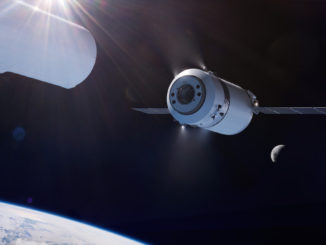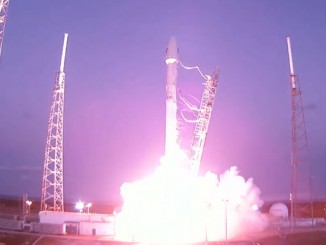EDITOR’S NOTE: Updated at 11 a.m. EST (1600 GMT) with image of booster.
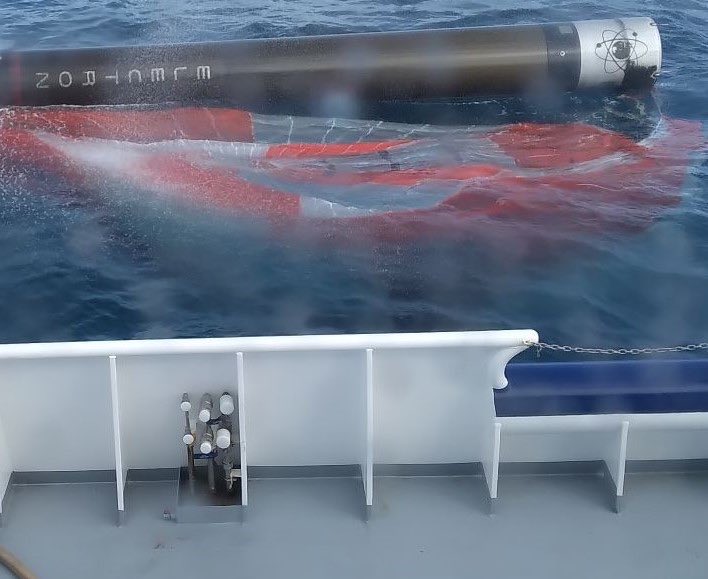
Rocket Lab says the first stage of its Electron launcher splashed down under parachute in the Pacific Ocean off New Zealand after firing into space with 30 small satellites Thursday, becoming only the second private company to return an orbital-class booster to Earth intact.
Suspended under a circular parachute, the carbon composite booster stage descended to a splashdown a few hundred miles downrange from Rocket Lab’s launch base in New Zealand, according to Rocket Lab.
A recovery team stationed in the Pacific Ocean moved in to secure the booster before hoisting it onto a vessel for the journey back to New Zealand for inspections.
The successful splashdown of the Electron’s first stage moved California-based Rocket Lab closer to reusing rocket boosters, which the company says will allow it to launch missions at a faster cadence, and potentially cut costs.
“What the team achieved today in recovering Electron’s first stage is no mean feat,” said Peter Beck, Rocket Lab’s founder and CEO, in a statement. “It took a monumental effort from many teams across Rocket Lab, and it’s exciting to see that work pay off in a major step towards making Electron a reusable rocket.”
Rocket Lab intends to eventually use a helicopter to snare rocket stages descending under parachutes in mid-air, eliminating contamination from sea water. But Beck said before the launch that Rocket Lab would initially try recovering Electron boosters from the sea.
Designed to haul small satellites into orbit, the privately-developed Electron rocket has flown 16 times, including Thursday’s mission. Late last year and early this year, Rocket Lab instrumented Electron boosters to study the heating, aerodynamic, and structural loads they encounter during re-entry.
But this launch, which Rocket Lab nicknamed “Return to Sender” in a nod to the recovery attempt, was the first time an Electron rocket flew with parachutes to attempt a full series of descent maneuvers.
The mission began with a liftoff from Rocket Lab’s private spaceport on Mahia Peninsula, located on the east coast of New Zealand’s North Island, at 9:20:01 p.m. EST Thursday (0220:01 GMT; 3:20:01 p.m. New Zealand time Friday).
Liftoff of Rocket Lab’s Electron launcher, making strides toward reusability while serving customers in the United States, France, and New Zealand.https://t.co/jmkTwAj679 pic.twitter.com/GZAqOjWmA3
— Spaceflight Now (@SpaceflightNow) November 20, 2020
Nine kerosene Rutherford engines on the Electron first stage propelled the nearly 60-foot-tall (18-meter) rocket toward the south from the launch base. Two-and-a-half minutes later, the first stage shut down its engines and separated at an altitude of 50 miles (80 kilometers) freeing the Electron’s second stage to ignite a single engine to continue flying into orbit.
Meanwhile, thrusters on the first stage flipped the 40-foot-long (12-meter) booster around 180 degrees to fly engines first, configuring the rocket for re-entry back into the atmosphere. After coasting to an apogee, or high point, of its trajectory near the edge of space, the booster began falling back toward the Pacific Ocean.
After plunging into the thick, lower layers of the atmosphere — “hitting the wall,” as Beck calls it — the booster deployed a pilot parachute, a drogue chute, and then a circular main chute as designed. The main parachute slowed the rocket for splashdown in the Pacific Ocean.
Beck tweeted a photo from a upward-facing camera an-board the Electron booster, writing that the image was his new favorite for 2020.
Officials said before the mission that the parachute system is designed to slow the rocket’s descent to about 10 meters per second, or 22 mph. Beck said before the mission that the company did not expect any significant damage to the rocket from the splashdown, “other than everything getting wet.”
Rocket Lab’s live video stream from the booster cut out as it began re-entry, but the company quickly confirmed that the rocket unfurled its parachutes and reached the sea as designed.
Beck tweeted an image of the floating stage later Friday, writing “Welcome back to Earth Electron!”
“Well done,” replied Eon Musk, founder and CEO of SpaceX, the only other private company to retrieve an orbital-class rocket stage intact.
Rocket Lab’s offshore team planned to place flotation aids around the booster, then install a collar before lifting the rocket by crane onto the recovery ship.
Engineers are eager to inspect the rocket once it’s back in Rocket Lab’s factory.
“Once we get it back into the factory, it’s like a CSI really,” Beck said in a conference call with reporters earlier this month. “We’ll pull it all apart and really dig into how well each of the components and the sub-assemblies performed. It’ll be a very time-consuming process to go back and see what we’ve got.”
Beck said the company is taking an incremental approach to proving out its ability to recover and reuse Electron rocket boosters. Engineers want to see how well the booster survives re-entry, and it’s likely Rocket Lab will try several water splashdowns before attempting a mid-air recovery for the first time.
“If we’ve got a smoldering stump, then there’s really not much point in catching a smoldering stump with a helicopter,” Beck said earlier this month.
The first stage of Rocket Lab’s Electron launcher has shut down and jettisoned to begin its descent toward the Pacific Ocean for today’s recovery attempt.
The rocket’s upper stage is firing into orbit.
Watch live: https://t.co/jmkTwAj679 pic.twitter.com/PetQUX00Oj
— Spaceflight Now (@SpaceflightNow) November 20, 2020
Rocket Lab aims to become the second commercial rocket company to recover and reuse orbital-class boosters. SpaceX landed its first Falcon 9 booster in 2015, and began re-flying Falcon 9 rockets in 2017.
SpaceX uses cold gas thrusters to re-orient its Falcon 9 first stages, then reignites a subset of the Falcon 9’s Merlin engines to slow down for propulsive landings, using thrust and grid fins to steer it back to a drone ship at sea or toward an onshore recovery site.
Rocket Lab also uses cold gas thrusters on its booster, but the company is taking a different approach for recovery.
SpaceX’s Falcon 9 is much larger than Rocket Lab’s Electron vehicle, with enough performance margin for engineers to reserve propellant for propulsive landing maneuvers during mid-air restarts of the Falcon 9’s main engines.
That won’t work for smaller satellite launchers like the Electron, which needs all of its propellant to place payloads into orbit.
Beck said the addition of recovery hardware takes away about 7.5% of the Electron rocket’s overall launch capacity to sun-synchronous orbit. SpaceX takes a bigger performance hit by percentage when it lands a Falcon 9 booster.
SpaceX initially tried using parachutes to recover its Falcon 1 and Falcon 9 boosters, but those attempts didn’t work. The company eventually switched to a design for vertical landings of the Falcon boosters on floating ships in the ocean, or at an onshore landing site near the launch pad.
The main goal of the Rocket Lab’s reuse program is to increase the company’s launch rate, but Beck said the initiative could also cut prices lower than the company’s already low figures.
“We’ve seen the cost of dedicated small launch come from anywhere from $50 million to $30 million for a Pegasus or a Minotaur (rocket) down to $7 million for a Rocket Lab vehicle,” Beck said.
If Rocket Lab is successful with reusing its boosters, “I think we’ll see a dramatic change in pricing again,” Beck said.
My new favourite image of 2020. pic.twitter.com/lEIXPyCIkI
— Peter Beck (@Peter_J_Beck) November 20, 2020
While the first stage parachuted into the Pacific Ocean, the Electron’s second stage deployed the mission’s 30 payloads and kick stage into a preliminary transfer orbit. Within an hour of launch, the kick stage reignited to place the small payloads into a near-circular 310-mile-high (500-kilometer) orbit.
Two of the spacecraft on the Electron launch were built by Millennium Space Systems, a subsidiary of Boeing, for a mission named DragRacer to test a drag-inducing device that could help small satellites in low Earth orbit naturally decay, or re-enter the atmosphere.
One satellite — named Alchemy — will extend a 230-foot-long (70-meter) electrically conductive tether, a device designed to increase the surface area of the spacecraft, allowing it to succumb to aerodynamic drag, re-enter the atmosphere, and burn up.
Both DragRacer spacecraft are identical, except that one carries the tether and the other — named Augury — does not.
According to preflight predictions, the satellite with the tether could re-enter the atmosphere within 45 days. The spacecraft without the tether — the control for the experiment — is expected to remain in orbit for around seven years, according to mission team members.
The device affixed to DragRacer’s Alchemy satellite is called a Terminator Tape. Developed by Tethers Unlimited, the tape measures just a few inches wide, but it can spool out to lengths of hundreds of feet.
The DragRacer experiment is a purely commercial experiment to quantify the effectiveness of the Terminator Tape technology, which Millennium and Tethers Unlimited say is a more reliable, lower cost, and less complex alternative to other deorbit methods, such as drag sails or propulsive thrusters.
“This scientific method experiment will demonstrate Millennium’s ability to field and fly a low-cost and straightforward orbital debris mitigation solution that doesn’t require added mass, volume, cost and complexity of propulsion system to deorbit a satellite in low Earth orbit,” said Stan Dubyn, founder and CEO of Millennium Space Systems, in a press release.
The two DragRacer satellites have a combined weight of around 55 pounds, or 25 kilograms, according to TriSept Corp., a partner on the DragRacer mission overseeing the integration of the satellites on the Rocket Lab launcher.
Ground-based radars will track the changing orbits of both DragRacer spacecraft to measure how they decay differently.
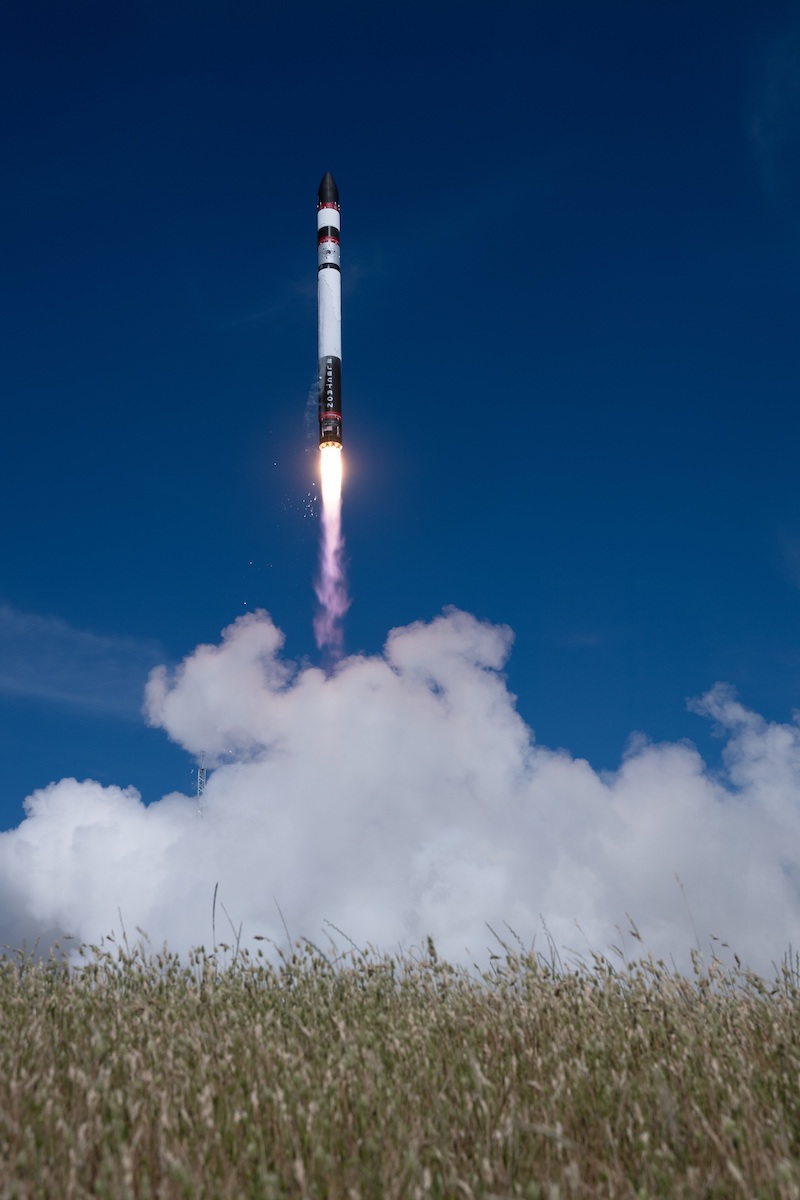
“The space community understands tether systems can expedite re-entry, but this is our first opportunity to truly quantify performance directly and more effectively calibrate models developed over the last 50 years,” said Robert Hoyt, founder and CEO of Tethers Unlimited. “Predictions suggest the tethered spacecraft will deorbit in approximately 45 days, while the untethered spacecraft remains in orbit for approximately 7 to 9 years.”
Tethers Unlimited’s Terminator Tape technology has flown before. The company says the tether module — which attaches on the exterior of a host spacecraft — weighs about 2 pounds and is about the size of a notebook, and is suitable for a range of satellite sizes.
The Prox-1 microsatellite developed by students at Georgia Tech deployed 230-foot-long Terminator Tape last year. Tethers Unlimited said tracking of the spacecraft showed its orbit decaying 24 times faster after extending the tether.
Flying two identical satellites on the DragRacer mission will allow engineers to better characterize the performance of the tether technology.
“The mission is completely about the demonstration,” said Jason Armstrong, director of TriSept’s launch and integration services, in an interview last year with Spaceflight Now. “So immediately upon separation from the launch vehicle, the two halves of the spacecraft will come apart from each other, and then we can deploy the tether on one half of the spacecraft and get immediate results.”
Armstrong said the benefit of the Terminator Tape over other deorbit solutions is its smaller volume and mass.
“It’s much less complex as far as the capabilities you need to have for actuating and deploying the system,” Armstrong said. “On-board, all we need to have is a small timer with a little battery mechanism. That’s very attractive (to satellite operators) because you’re not introducing risk or any high complexity systems that have to talk to your flight computer.”
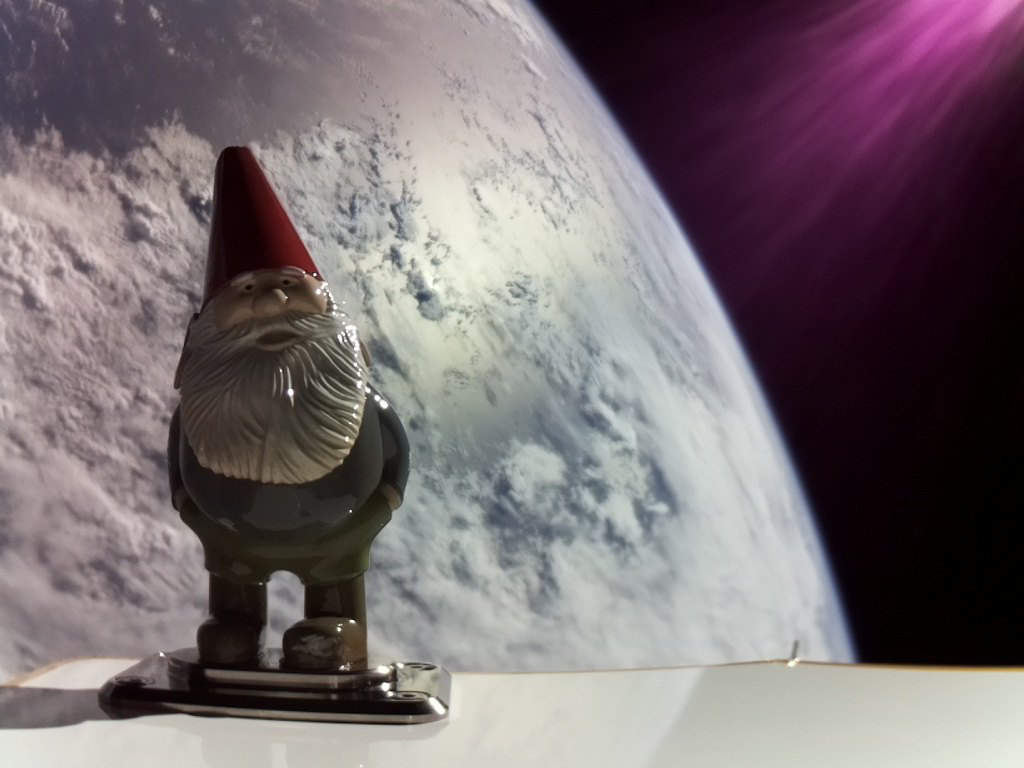
Other payloads launched on Rocket Lab’s mission Thursday night include two briefcase-sized CubeSats for a French startup named UnseenLabs. Built by the Danish smallsat manufacturer GomSpace, the Bro-2 and Bro-3 satellites are the second and third launched for UnseenLabs.
The French company plans to field a constellation of 20 to 25 satellites over the next five years for maritime surveillance. UnseenLabs says its fleet of nanosatellites will be able to locate and identify ships around the world, providing tracking services for maritime operators and helping security forces watch for pirates and smugglers.
Swarm Technologies had 24 of its tiny SpaceBEE satellites, each about the size of a slice of bread, on the Electron rocket. The “BEE” in SpaceBEE stands for Basic Electronic Element.
We launched our latest 24 satellites tonight and have made contact with them! This brings our commercial constellation to 36, more than doubling our network capacity for our customers. Thanks @RocketLab for the smooth ride to space! https://t.co/B45P7qlpNy pic.twitter.com/hlHlkLrEju
— Swarm Technologies (@SwarmInternet) November 20, 2020
Swarm is developing a low-data-rate satellite communications fleet the company says could be used by connected cars, remote environmental sensors, industrial farming operations, transportation, smart meters, and for text messaging in rural areas outside the range of terrestrial networks.
New Zealand’s first satellite designed and built by university satellites also rode into orbit on the Electron rocket.
Designed and built at the University of Auckland, the CubeSat is named Te Waka Āmiorangi o Aotearoa, which translates in English to New Zealand Satellite Vessel. It’s also known as APSS-1, using the acronym for the Auckland Program for Space Systems.
The spacecraft carries an instrument to measure electrical disturbances in the ionosphere to investigate how they might be linked to earthquakes.
Rocket Lab launched the APSS 1 satellite at no charge, according to the University of Auckland.
A “mass simulator” in the form of Gnome Chompski, an item from the “Half-Life” video game, will remain attacked to the Electron rocket’s kick stage after it releases the mission’s other payloads. The space-bound gnome was created for Gabe Newell, founder of the video game company Valve.
“Manufactured with support from multi-award-winning design studio Weta Workshop, the unique space component is additively manufactured from titanium and printed in the shape of Half-Life gaming icon Gnome Chompski,” Rocket Lab writes in the press kit for Thursday’s mission. “The mission serves as an homage to the innovation and creativity of gamers worldwide, and also aims to test and qualify a novel 3D printing technique that could be employed for future spacecraft components. The 150 mm gnome will remain attached to Electron’s kick stage and will de-orbit with it when the stage burns up on re-entry to the Earth’s atmosphere.
Email the author.
Follow Stephen Clark on Twitter: @StephenClark1.


